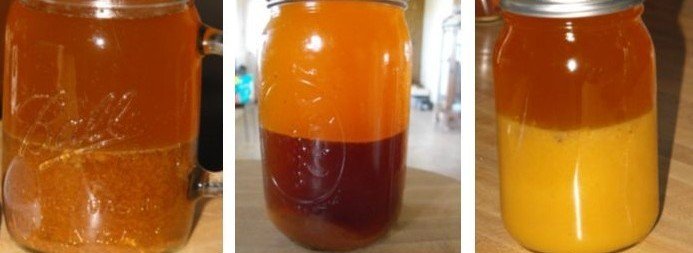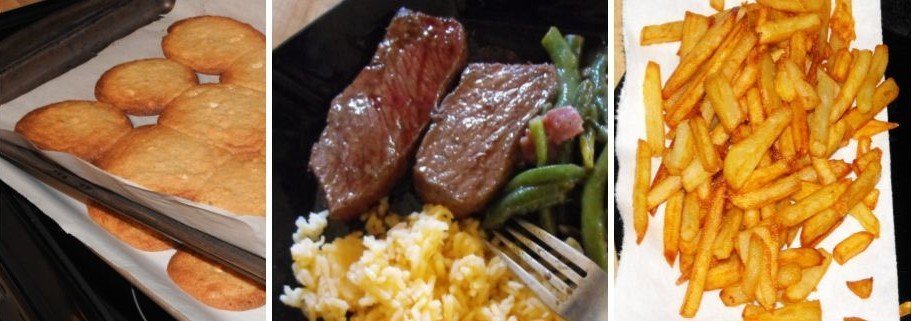duck fat
Duck fat is a very aromatic fat that can be used for many things in the kitchen. The average 2015 sale price online was $25/lb., quite a bit more than butter.
Duck fat can be stored in the freezer for well over a year. Use the fat to make confit or for other cooking. Cookies made with duck fat are delicious.
The gelatin mix makes a good base for soups or sauces.
A. Collecting duck fat
2014-10-10 a.o.
To get duck fat, you don’t have to do anything unusual. Just don’t throw it away!
 Pic1: roast drippings
Pic1: roast drippingsPic2: fat floats on top
Pic3: cooking duck skin
Directions
- When roasting a duck, poke holes in the skin, or cut through the skin into the fat layer to let the fat leak out during cooking. Collect the drippings with the fat and separate them.
- When steaming or boiling a duck, the fat will be floating on top of the cooking liquid. Refrigerate and the next day it will be easy to collect.
- When braising or stewing with vegetables, the fat can mix in with the rest of the food. This can make a stew quite greasy. Skin the duck before cooking to avoid this and cook the skin separately to render out the fat.
 Pic4: 2015-05-26
Pic4: 2015-05-26Pic5: 2014-07-16
Pic6: 2014-10-10 with orange juice
These are 3 jars with duck fat from different cookings. Depending on how the duck was cooked and what was cooked with it, the stock can have different colors.
When cooking with fat-soluble spices like turmeric or paprika, the fat itself will take on a different color.
B. separating duck fat from stock
2016-02-24
Cooking a duck can render as much as a pint of fat, but it is often mixed in with the watery part. To make confit or to freeze the fat for long-term storage, you want pure fat without water.
Directions
What you need for cold separation:
|
What you need for warm separation:
|
Cold separation is easy, but it can take more than 24 hours to refrigerate enough to solidify the fat.
- Pour the stock in a container.
Because water is heavier than fat, the two will separate. (Pic7) - Refrigerate the jar.
- The watery part will gel, usually before the fat is completely solid.
At this time it is easy to scoop or even pour the fat off the gel. - The fat will eventually turn solid and a creamy white(-ish).
- Scoop the fat off the gel.
If the jar opening is too narrow, break the fat in several pieces.
Warm separation is messier, but this method can be useful if you need to separate the fat while it is still liquid. For your safety, wait until the fat is at room temperature.
 Pic7: fat on top, gelatin below
Pic7: fat on top, gelatin below
Pic8: fat is outside the jar
Pic9: minimal fat left in the jar
- Place the jar in a wider container on a level surface.
- If the jar isn’t full, add stock until nearly full.
- Wait until fat and gelatin / stock separate. (Pic1)
- Place the funnel in the jar.
- Slowly pour more stock in the funnel.
Do this slowly enough that the fat remains separate from the stock. - As more stock enters the jar, it will push the fat up and out of the jar.
A narrow jar or bottle opening will make this effect even more pronounced, allowing for better separation. - Slowly pour in more stock until the stock reaches the top of the jar. (Pic2)
- Carefully remove the jar.
- The container will have pure fat only.
C. rendering duck fat
2015-10-31
Most of the fat in a duck is in the layer directly under the skin. A skinned duck is quite lean. The easiest way to render duck fat is to skin a duck and cook that skin in its own fat. (Pic6)
If you eat duck only occasionally, cut the skin in small pieces and freeze them until you have enough to make a nice batch.
 Pic10: rendering fat
Pic10: rendering fatPic11: making duck cracklings
Pic12: duck cracklings
Directions
- Cut the skin in small pieces.
- Transfer the skin to a small saucepan.
Wet rendering produces the whitest and cleanest fat.
- Add enough water to cover it all. Bring to a boil.
- Once the water boils, the fat in the skin will start melting.
- The fat floats on top of the water.
- Always keep at least double the amount of water in the pot than fat.
This prevents the fat from heating up too much. - Pour off the fat occasionally.
- Continue boiling the skin in water until no more fat appears.
Dry rendering produces a darker, more aromatic fat.
- Add only up to 1 cup of water.
This gets the rendering going without burning the skin. - Water boils at a lower temperature than fat.
If you do not add water, eventually it will all will boil away. - The skin will be cooking in its own fat. (Pic10)
Be aware:- Fat can be heated to much higher temperatures than water.
- Keep the heat low enough that it does not become dangerous. A deep-fryer with thermostat would be safer for this than unchecked stovetop.
- When no more fat is being rendered, allow the fat to cool to room temperature.
- Strain/filter the fat at safe handling temperature to remove impurities.
- Store in freeze-proof containers. Freeze.
Unlike water, fat shrinks when cooled. Glass container won't explode when fat freezes, but are still a safety hazard because they can break upon impact with other frozen goods. - When frozen, repackage in vacuum-sealed bags for the longest shelf-life.
- Optional:
- Freeze the fat in ice-cube molds to have easy-to-handle small portions.
D. making duck cracklings
2015-10-31
The best way to render duck fat is to cook the skin until no more fat is released. This takes it one step further. The duck skin is cooked at higher heat until all moisture has been removed until you have duck cracklings. Duck skin can also be pickled, like pork rinds.
Directions
- Skin the duck.
- Slice and dice the skin in bite-sized pieces.
Duck skin is thicker than chicken, and comparatively more difficult to cut. - Toss in a hot skillet, add water and keep stirring until the fat begins to render. (Pic2)
- Simmer over medium to low heat until all the water evaporates from the fat and no more fat is rendered.
- Increase heat to 350-380 ºF. (Pic3)
A deep-fryer with thermostat would be safer for this than unchecked stovetop. - Deep-fry until the skin pieces are completely crisp.
The duck cracklings are ready when they are dark brown and no longer bubble with moisture. - Pat the cracklings dry on a piece of kitchen paper.
- Optional:
- Generously apply salt and spices of your choice.
- Weigh the cracklings down for up to 48 hrs. to flatten them.
- Serve and enjoy. (Pic1)
E. using duck fat in the kitchen
various dates
I rescued a Rouen duck from freezer camp today, minus the breast steaks.
Truth be told, Rouens are small and there is not much left to eat after cutting out those steaks. Duck legs are tiny compared to chicken legs, and the wings hardly have any meat on them. But even so, the taste is incredibly rich thanks to the duck fat. I prefer cooking a duck with the skin, even if I don't often eat that skin. Ducks have a lot of fat in and under the skin. That is where most of the duck fat comes from. Too bad there's so little of it in most ducks...
 Pic13: duck fat cookies
Pic13: duck fat cookiesPic14: London Broil seared / pan-fried in duck fat
Pic15: duck fat fries
Duck fat can be used in a lot of recipes instead of butter or oil.
Baking:
- Cookies baked with duck fat are delicious. (Pic13)
- Substitute up to a quarter of the butter with duck fat. More would be overpowering.
Frying:
- Duck breast, seared in duck fat is a real delicacy, much better than any beefsteak.
- However, duck fat can add extra flavor even to steaks. (Pic14)
Deep-frying:
- Potatoes deep-fried in duck fat get a beautiful brown crust, and taste wonderful too. (Pic15)
Other uses: